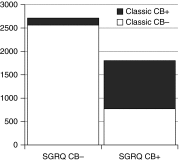Comparison between an alternative and the classic definition of chronic bronchitis in COPDGene
- PMID: 25575351
- PMCID: PMC4418311
- DOI: 10.1513/AnnalsATS.201411-518OC
Comparison between an alternative and the classic definition of chronic bronchitis in COPDGene
Abstract
Rationale: Previous studies on chronic bronchitis (CB) have used varying definitions.
Objectives: We sought to compare an alternative CB definition, using the St. George's Respiratory Questionnaire (SGRQ), a commonly used assessment tool, with the classic definition and to investigate if it had independent or additive value.
Methods: We analyzed data from 4,513 subjects from Global Initiative for Chronic Obstructive Lung Disease groups 1 to 4 in the COPDGene cohort. We compared the classic definition of CB with the SGRQ definition, defined by their answers to the questions about both cough and phlegm. We compared the Classic CB+ versus CB- groups, and the SGRQ CB+ and CB- groups. We also analyzed the cohort split into four groups: Classic CB+/SGRQ CB+, Classic CB+/SGRQ CB-, Classic CB-/SGRQ CB+, Classic CB-/SGRQ CB-.
Measurements and main results: A total of 26.1% subjects were Classic CB+, whereas 39.9% were SGRQ CB+. When the SGRQ definition was compared with the Classic CB definition, using this as the gold standard, the SGRQ CB definition had a sensitivity and specificity of 0.87 and 0.77, respectively. The SGRQ CB+ and Classic CB+ groups were strikingly similar, with more respiratory symptoms and exacerbations, worse lung function, and greater airway wall thickness. In addition, the Classic CB+/SGRQ CB+, Classic CB+/SGRQ CB-, and Classic CB-/SGRQ CB+ groups shared similar characteristics as well.
Conclusions: The SGRQ CB definition identifies more subjects with chronic cough and sputum who share a similar phenotype identified by the Classic CB definition. The addition of the SGRQ CB definition to the classic one can be used to identify more patients with chronic obstructive pulmonary disease at risk for poor outcomes.
Keywords: Saint George’s Respiratory Questionnaire; chronic bronchitis; chronic obstructive pulmonary disease.
Figures



References
-
- Vestbo J, Hurd SS, Agustí AG, Jones PW, Vogelmeier C, Anzueto A, Barnes PJ, Fabbri LM, Martinez FJ, Nishimura M, et al. Global strategy for the diagnosis, management, and prevention of chronic obstructive pulmonary disease: GOLD executive summary. Am J Respir Crit Care Med. 2013;187:347–365. - PubMed
-
- American Lung Association Trends in COPD (chronic bronchitis and emphysema): morbidity and mortality 2013. [accessed 2015 Feb 1]. Available from: http://www.lung.org/finding-cures/our-research/trend-reports/copd-trend-...
-
- Ferris BG. Epidemiology standardization project (American Thoracic Society) Am Rev Respir Dis. 1978;118:1–120. - PubMed
-
- Vestbo J, Prescott E, Lange P Copenhagen City Heart Study Group. Association of chronic mucus hypersecretion with FEV1 decline and chronic obstructive pulmonary disease morbidity. Am J Respir Crit Care Med. 1996;153:1530–1535. - PubMed
-
- Burgel PR, Nesme-Meyer P, Chanez P, Caillaud D, Carré P, Perez T, Roche N Initiatives Bronchopneumopathie Chronique Obstructive Scientific Committee. Cough and sputum production are associated with frequent exacerbations and hospitalizations in COPD subjects. Chest. 2009;135:975–982. - PubMed
Publication types
MeSH terms
Grants and funding
LinkOut - more resources
Full Text Sources
Other Literature Sources
Medical

